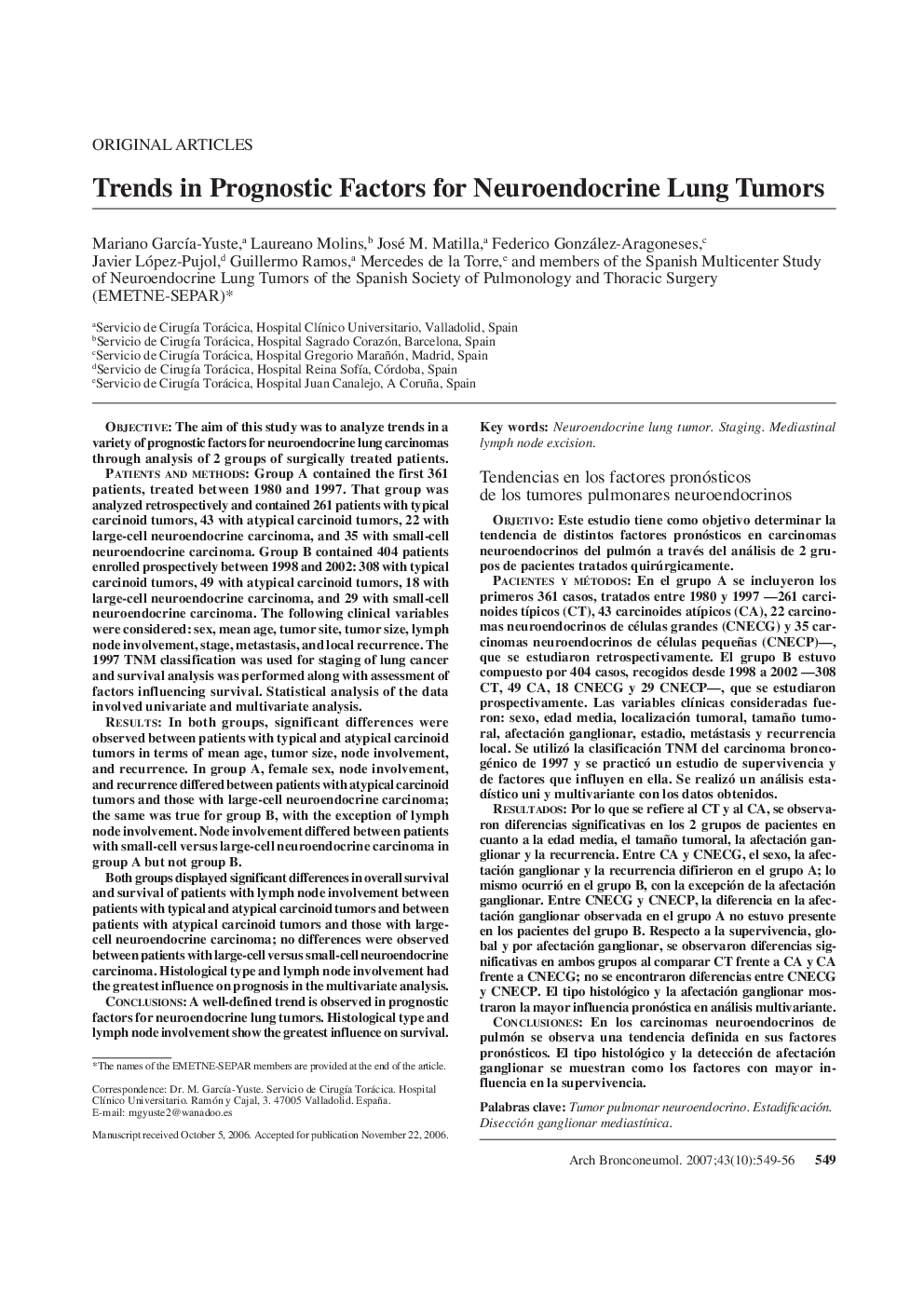| Article ID | Journal | Published Year | Pages | File Type |
|---|---|---|---|---|
| 4206622 | Archivos de Bronconeumología (English Edition) | 2007 | 8 Pages |
ObjectiveThe aim of this study was to analyze trends in a variety of prognostic factors for neuroendocrine lung carcinomas through analysis of 2 groups of surgically treated patients.PATIENTS AND METHODSGroup A contained the first 361 patients, treated between 1980 and 1997. That group was analyzed retrospectively and contained 261 patients with typical carcinoid tumors, 43 with atypical carcinoid tumors, 22 with large-cell neuroendocrine carcinoma, and 35 with small-cell neuroendocrine carcinoma. Group B contained 404 patients enrolled prospectively between 1998 and 2002: 308 with typical carcinoid tumors, 49 with atypical carcinoid tumors, 18 with large-cell neuroendocrine carcinoma, and 29 with small-cell neuroendocrine carcinoma. The following clinical variables were considered: sex, mean age, tumor site, tumor size, lymph node involvement, stage, metastasis, and local recurrence. The 1997 TNM classification was used for staging of lung cancer and survival analysis was performed along with assessment of factors influencing survival. Statistical analysis of the data involved univariate and multivariate analysis.RESULTSIn both groups, significant differences were observed between patients with typical and atypical carcinoid tumors in terms of mean age, tumor size, node involvement, and recurrence. In group A, female sex, node involvement, and recurrence differed between patients with atypical carcinoid tumors and those with large-cell neuroendocrine carcinoma; the same was true for group B, with the exception of lymph node involvement. Node involvement differed between patients with small-cell versus large-cell neuroendocrine carcinoma in group A but not group B.Both groups displayed significant differences in overall survival and survival of patients with lymph node involvement between patients with typical and atypical carcinoid tumors and between patients with atypical carcinoid tumors and those with large- cell neuroendocrine carcinoma; no differences were observed between patients with large-cell versus small-cell neuroendocrine carcinoma. Histological type and lymph node involvement had the greatest influence on prognosis in the multivariate analysis.CONCLUSIONSA well-defined trend is observed in prognostic factors for neuroendocrine lung tumors. Histological type and lymph node involvement show the greatest influence on survival.
ObjetivoEste estudio tiene como objetivo determinar la tendencia de distintos factores pronósticos en carcinomas neuroendocrinos del pulmón a través del análisis de 2 grupos de pacientes tratados quirúrgicamente.PACIENTES Y MÉTODOSEn el grupo A se incluyeron los primeros 361 casos, tratados entre 1980 y 1997 —261 carcinoides típicos (CT), 43 carcinoides atípicos (CA), 22 carcinomas neuroendocrinos de células grandes (CNECG) y 35 carcinomas neuroendocrinos de células pequeñas (CNECP)—, que se estudiaron retrospectivamente. El grupo B estuvo compuesto por 404 casos, recogidos desde 1998 a 2002 —308 CT, 49 CA, 18 CNECG y 29 CNECP—, que se estudiaron prospectivamente. Las variables clínicas consideradas fueron: sexo, edad media, localización tumoral, tamaño tumoral, afectación ganglionar, estadio, metástasis y recurrencia local. Se utilizó la clasificación TNM del carcinoma broncogénico de 1997 y se practicó un estudio de supervivencia y de factores que influyen en ella. Se realizó un análisis estadístico uni y multivariante con los datos obtenidos.RESULTADOSPor lo que se refiere al CT y al CA, se observaron diferencias significativas en los 2 grupos de pacientes en cuanto a la edad media, el tamaño tumoral, la afectación ganglionar y la recurrencia. Entre CA y CNECG, el sexo, la afectación ganglionar y la recurrencia difirieron en el grupo A; lo mismo ocurrió en el grupo B, con la excepción de la afectación ganglionar. Entre CNECG y CNECP, la diferencia en la afectación ganglionar observada en el grupo A no estuvo presente en los pacientes del grupo B. Respecto a la supervivencia, global y por afectación ganglionar, se observaron diferencias significativas en ambos grupos al comparar CT frente a CA y CA frente a CNECG; no se encontraron diferencias entre CNECG y CNECP. El tipo histológico y la afectación ganglionar mostraron la mayor influencia pronóstica en análisis multivariante.CONCLUSIONESEn los carcinomas neuroendocrinos de pulmón se observa una tendencia definida en sus factores pronósticos. El tipo histológico y la detección de afectación ganglionar se muestran como los factores con mayor influencia en la supervivencia.
